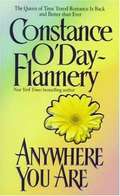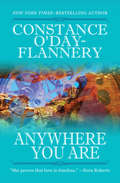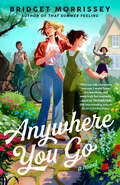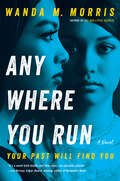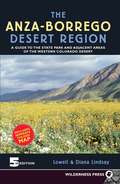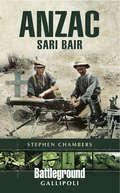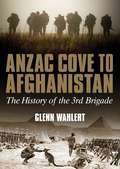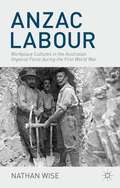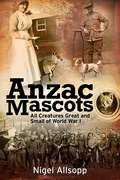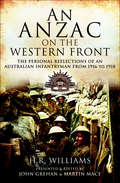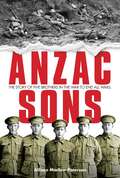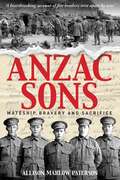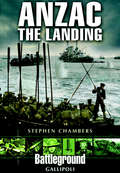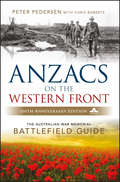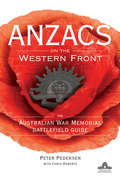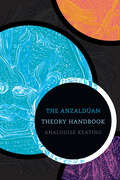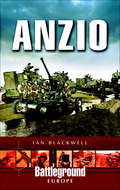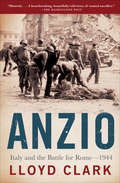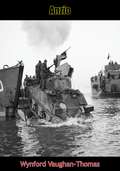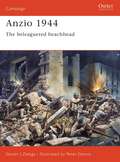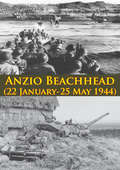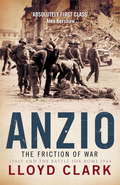- Table View
- List View
Anywhere You Are
by Constance O'Day-FlanneryWhen a rugged, wild, but incredibly breathtaking man approaches Mairie Callahan, she is unprepared for the enticing tremors of passion she feels. But there is something unusual about this stranger... and something peculiar about what's happened to Mairie. For when she crazily agreed to go skydiving with her brother, she expected to land somewhere outside of Las Vegas, but Jack Delaney, as this stranger introduces himself, tells her she has landed in a different place--and time... Jack Delaney has returned to his adoptive home among the Paiute Indians, hoping to regain the soul he'd lost fighting in the Civil War. He seeks solace and a new life in the vast expanse of the Nevada wilderness. Then one day something falls from the skies. It's woman--captivatingly beautiful--who says she's from another time. Soon, he can't imagine losing her, which makes each moment she spends with him all the more precious...
Anywhere You Are
by Constance O'Day-FlannerySkydiving in Las Vegas lands a modern-day woman in the past—and in the arms of her true love—in this romance from the New York Times–bestselling author. When Mairie Callahan jumps out of an airplane high above the Nevada desert, she simply hopes that her parachute will open. What she doesn't expect is that she'll land a hundred and twenty-two years in the past.... When Jack Delaney returns home from the Civil War in 1877, he hopes a vision quest amongst his adoptive Paiute Indian brothers will bring him peace. Instead, it brings a strange, beautiful woman falling from the sky.... Even though Mairie's ravings about "the future" seem crazy to Jack, he can't help but be drawn to her. She's unlike any woman he's ever met. Soon the two are racing to return Mairie home to her dying brother with an extinct plant that might save him. Will she return in time? Will they survive the danger along the way? And, is the bond forming between them more than friendship? Is it love? In ANYWHERE YOU ARE, Constance O&’Day-Flannery, the original &“Queen of Time Travel Romance,&” mixes a timeless love story with a harrowing adventure that unites two souls born a century apart.
Anywhere You Go
by Bridget MorrisseyA small-town waitress and a big-city Broadway press agent swap homes to escape the messiness of their personal lives, only to find new purpose—and new love.Tatum Ward and Eleanor Chapman lead totally opposite lives. Tatum&’s never left her Midwestern hometown. She resides in a quaint guest cottage on her parents&’ property while working part-time as a waitress, where she spends most shifts ignoring her feelings for a beautiful regular named June. Eleanor dedicates every waking hour to her high-profile press career, sacrificing personal relationships for professional success, save for the occasional hookup to fight off her loneliness. When both women&’s lives unexpectedly blow up at the exact same time, they each need an escape, and fast.In Tatum&’s hometown, Eleanor expects a quiet hideaway where she can recharge. Instead she gets wrapped up in the family drama that Tatum left town to avoid, pulled in by Tatum&’s charismatic older sibling, Carson, who charms Eleanor at every turn. Tatum ends up in Eleanor&’s New York high-rise apartment with June. One week together in the big city might make it impossible for Tatum to avoid not just her true feelings for June, but her real dreams for her life.Amid a friendship with a reclusive Hollywood actress and a complicated family reunion, Tatum and Eleanor each discover much more than they bargained for away from home. Their house swap won&’t last forever, but it might be just long enough for both women to surrender their defenses and finally fight for the life—and love—they deserve.
Anywhere You Run: A Novel
by Wanda M. Morris"Wise, riveting, and full of surprises, Anywhere You Run will keep you up past your bedtime and stay with you long after the book is closed.” —Lisa Unger, New York Times bestselling author of Secluded Cabin Sleeps SixFrom the award-winning author of All Her Little Secrets comes yet another gripping, suspenseful novel where, after the murder of a white man in Jim Crow Mississippi, two Black sisters run away to different parts of the country . . . but can they escape the secrets they left behind?It’s the summer of 1964 and three innocent men are brutally murdered for trying to help Black Mississippians secure the right to vote. Against this backdrop, twenty-one year old Violet Richards finds herself in more trouble than she’s ever been in her life. Suffering a brutal attack of her own, she kills the man responsible. But with the color of Violet’s skin, there is no way she can escape Jim Crow justice in Jackson, Mississippi. Before anyone can find the body or finger her as the killer, she decides to run. With the help of her white beau, Violet escapes. But desperation and fear leads her to hide out in the small rural town of Chillicothe, Georgia, unaware that danger may be closer than she thinks.Back in Jackson, Marigold, Violet’s older sister, has dreams of attending law school. Working for the Mississippi Summer Project, she has been trying to use her smarts to further the cause of the Black vote. But Marigold is in a different kind of trouble: she’s pregnant and unmarried. After news of the murder brings the police to her door, Marigold sees no choice but to flee Jackson too. She heads North seeking the promise of a better life and no more segregation. But has she made a terrible choice that threatens her life and that of her unborn child? Two sisters on the run—one from the law, the other from social shame. What they don’t realize is that there’s a man hot on their trail. This man has his own brand of dark secrets and a disturbing motive for finding the sisters that is unknown to everyone but him . . .“Anywhere You Run had me hooked from the first page... It’s a novel both tender and ferocious—an absolute stunner.” —Lou Berney, Edgar Award–winning author of November Road
Anza-Borrego Desert Region
by Lowell Lindsay Diana LindsayNow in its expanded 5th edition, The Anza-Borrego Desert Region offers complete coverage of the over 1 million acres of desert lands, including Anza-Borrego State Park, Ocotillo Wells State Vehicular Recreation Area (OWSVRA), parts of the Santa Rosa and San Jacinto Mountains National Monument, and adjacent BLM recreational and wilderness lands.
Anzac: Sari Bair (Battleground Gallipoli)
by Stephen ChambersThe August Offensive was born out of the failures of the Gallipoli landings and the subsequent battles of late spring and early summer 1915. General Sir Ian Hamilton, Commander-in-Chief of the Mediterranean Expeditionary Force, chose to play all his remaining cards in this daring and ingenious gamble that he hoped would finally turn the tide in the allies favour and bring his army up onto the heights overlooking the elusive Dardanelles. However the plan's same ingenuity became its eventual undoing. It required complex manoeuvring in tortuous terrain; whilst many of the attacking soldiers were already weakened by the hardships of four months of enduring very poor conditions on the Peninsula. What played out was heartbreakingly tragic; command failed the bravery and sacrifice of the fighting soldier. This Anzac offensive, fought by a combined force of British, Australian, New Zealand and Indian troops, made infamous places such as Lone Pine, The Nek, Sari Bair, Chunuk Bair, Hill Q, The Farm, Hill 971 and Hill 60. Although tantalisingly close to success, the offensive fell short of its objectives and the attack was ground down to a stalemate - not least the consequence of the inspiring leadership of Mustafa Kemal. Hamilton's gamble had failed. This is the story, told using a rich mix of letters, diaries, photographs and maps, of Gallipoli's last battles; the forlorn hope for a decisive victory.As featured in the West Sussex County Times and All About Horsham Magazine.
Anzac Battlefield
by Sagona, Antonio and Atabay, Mithat and Mackie, C.J. and McGibbon, Ian and Reid, Richard Antonio Sagona Mithat Atabay C. J. Mackie Ian Mcgibbon Richard ReidAnzac Battlefield: A Gallipoli Landscape of War and Memory explores the transformation of Gallipoli's landscape in antiquity, during the famed battles of the First World War and in the present day. Drawing on archival, archaeological and cartographic material, this book unearths the deep history of the Gallipoli peninsula, setting the Gallipoli campaign in a broader cultural and historical context. The book presents the results of an original archaeological survey, the research for which was supported by the Australian, New Zealand and Turkish Governments. The survey examines materials from both sides of the battlefield, and sheds new light on the environment in which Anzac and Turkish soldiers endured the conflict. Richly illustrated with both Ottoman and Anzac archival images and maps, as well as original maps and photographs of the landscape and archaeological findings, Anzac Battlefield is an important contribution to our understanding of Gallipoli and its landscape of war and memory.
ANZAC Cove to Afghanistan: The History of the 3rd Brigade
by Glenn WahlertAs the first Anzacs to land at Gallipoli on 25 April 1915 and among the last to serve in Afghanistan 100 years later, the men and women of the Australian Army&’s 3rd Brigade have a long and proud history. Initially raised in 1903, the 3rd Brigade served as part of the Australian Imperial Force during World War I, suffering appalling losses at Gallipoli. On the Western Front the brigade endured three years of horrendous trench warfare, its four infantry battalions alone incurring a casualty rate of over 300%. During the inter-war period the brigade was a militia force and was mobilised with Japan&’s entry into the war in 1941, serving in Darwin, Papua New Guinea and North Queensland. Disbanded in 1944 and re-formed as the 3rd Task Force in 1967, the soldiers of the 3rd Brigade have deployed to almost every theatre in which the Australian Defence Force has seen action, including Vietnam, the South Pacific, Somalia, Cambodia, Rwanda, Bougainville, Timor-Leste, Solomon Islands, Iraq and Afghanistan. From 1980 the brigade has been the government&’s land force instrument of first choice in response to military or peacekeeping interventions throughout the world and natural disasters at home. This is a heritage of which all Australians can be justifiably proud.
Anzac Labour
by Nathan WiseAnzac Labour explores the horror, frustration and exhaustion surrounding working life in the Australian Imperial Force during the First World War. Based primarily on the letters, diaries and memoirs of Australian soldiers, this book traces the history of work and workplace cultures through the training camps of Australia, the shores of Gallipoli, the fields of France and Belgium, and the desert sands of the Near East. The reader is guided through soldiers' experiences of digging through dead bodies in the trenches of the Western Front, the tension surrounding carting supplies through sniper fire on Gallipoli, and the weariness experienced by light-horsemen on long patrols through the unforgiving Egyptian desert. Anzac Labour describes how, over several long years of conflict, Australian soldiers committed their minds and bodies not only to combat but also to the daily slog of military work, truly earning their tag as 'diggers'.
Anzac Mascots: All Creatures Great and Small of World War I
by Nigel AllsoppAnimals have the power to change people’s lives. They can be loving, loyal companions that will never judge. In World War I, many Australian and New Zealand units – army, naval and air squadrons – had animal mascots. <p><p> This thoroughly researched book containing a treasure trove of archival photographs shows that all types of animals served as mascots – a virtual Noah`s Ark of animals ranging from dogs and cats, rats and insects to bears and primates, birds and donkeys. Anzac Mascots explores animal mascots, both official and unofficial, that served in World War I, and aims to illustrate their purpose, how they were selected, what happened to them after the war and, finally, the far-reaching effects their prolific use had after the war. <p><p> This book reveals that people alone did not win World War I; animals played a vital part. Animals, through their unwavering devotion and boundless affection, kept soldiers&’ spirits high, provided a temporary link to normality and peace, and reminded what they were fighting for – home and country.
An Anzac on the Western Front: The Personal Reflections of an Australian Infantryman from 1916 to 1918
by H.R. Williams&“A remarkably candid and graphic account&” of the World War I service of a member of the Australian and New Zealand Army Corps (Britain at War Magazine). Having enlisted in 1915 and serving in the 56th Battalion Australian Imperial Force, Harold Roy Williams arrived in France, from Egypt, on June 30, 1916. He describes the horrors of the Fromelles battlefield in shocking clarity and the conditions the troops had to endure are revealed in disturbing detail. Surviving a later gas attack, Harold Williams&’s subsequent postings read like a tour of the Western Front. Following the Somme, there was the mud and squalor of the line south of Ypres, the German Spring Offensive of 1918, the Battle of Amiens—frequently described as the most decisive battle against the Germans in France and Flanders—the capture of Villers-Bretonneux and, finally, the assault on Péronne. Injured at Péronne and invalided back to the United Kingdom, Williams survived the war to return to Australia in 1919. An Anzac on the Western Front is his vivid description of his service in the First World War—an account that was described as &“the best soldier&’s story . . . yet read in Australia&” when it was first published. &“Williams&’ experience was defined by his rise from private soldier to platoon commander and he confined his writing to it. This is a story of cold, hunger, injury, fear, humour, friendship and death . . . So bloody good.&” —War History Online
ANZAC Sons: The Story of Five Brothers in the War to End All Wars (Australia Remembers Ser.)
by Allison Paterson"Well dear Jim it breaks my heart to write this letter. Our dear [brother] was killed yesterday morning at 5.30. The bullet killed him instantly and he never spoke a word. I had just left him and gone down the trench to see the other lads when I was called back. Oh Jim it is awful…Oh I do hope he is the last… " It is April 27, 1918, Jim&’s brother writes from the battlefields of France. Of five brothers serving on the Western Front, three have given their lives; another has been hospitalised. Six agonising months of brutal warfare were yet to be endured. The Great War was a senseless tragedy. Its long shadow darkened the four corners of the world. In Mologa, Victoria, once a bustling community, stands a lonely stone memorial. Etched within the granite are the names of the Marlow brothers and their mates; a testament to ordinary people who became heroes. ANZAC Sons is composed from a collection of over five hundred letters and postcards written by the brothers who served. From the training grounds of Victoria, Egypt and England, to the Western Front battlefields - Pozieres, Bullecourt, Messines, Menin Road, Passchendaele, Villers-Bretonneux and the village battles of 1918 – this compelling true story was compiled by the granddaughter of a surviving brother. She takes us on her journey as she walks in the footsteps of her ancestors. This is a story of mateship, bravery and sacrifice; it is a heartbreaking account of a family torn apart by war. It is a pledge to never forget.
Anzac Sons: Mateship, Bravery and Sacrifice
by Allison Paterson…Well dear Jim it breaks my heart to write this letter. Our dear [brother] was killed yesterday morning at 5.30. The bullet killed him instantly and he never spoke a word. I had just left him and gone down the trench to see the other lads when I was called back. Oh Jim it is awful … Oh I do hope he is the last … It is April 27, 1918, Jim&’s brother writes from the battlefields of France. Of five brothers serving on the Western Front, three have given their lives; another has been hospitalized. Six agonizing months of brutal warfare were yet to be endured … World War I was a senseless tragedy. Its long shadow darkened the four corners of the world. In Mologa, Victoria, once a bustling community, stands a lonely stone memorial. Etched within the granite are the names of the Marlow brothers and their mates; a testament to ordinary people who became heroes. Anzac Sons is composed from a collection of over 500 letters and postcards written by the brothers who served. From the training grounds of Victoria, Egypt and England, to the Western Front battlefields – Pozieres, Bullecourt, Messines, Menin Road, Passchendaele, Villers-Bretonneux and the battles of 1918 – this compelling true story was compiled by the granddaughter of a surviving brother. She takes us on her journey as she walks in the footsteps of her ancestors.This is a story of mateship, bravery and sacrifice; it is a heartbreaking account of a family torn apart by war. It is a pledge to never forget.
Anzac–The Landing: Gallipoli (Battleground Gallipoli)
by Stephen ChambersThe Anzac legend was born on the shores of Gallipoli during the historic morning of 25th April 1915. Landing on a hostile beach, under the cover of darkness, the Anzacs moved inland rapidly, but the response of the Ottoman forces was equally quick. The outcome of the campaign was arguably sealed during the first day, when the door for an Anzac victory was closed. With the order to dig, dig, dig and to stick it out, a stalemate was secured from the clutches of almost total disaster. After the Australians and New Zealanders received their baptism of fire, they became a stubborn thorn in the sides of the Ottoman army. Futilely after eight grueling months of fighting, the campaign came to an end with the complete evacuation of the Gallipoli Peninsula.Failure did not mar the actions and sacrifice of the Anzacs who bestowed a powerful legacy, as well as being a landmark in the birth of modern Turkey. Almost a century later, with all the veterans now sadly gone, their legacy still survives in Anzac Day and with the ever increasing numbers of pilgrims who visit the battlefield today.This attractive and well-written book will serve as either a handy guide or concise history (or both).
Anzacs in the Middle East: Australian Soldiers, Their Allies and the Local People in World War II
by Mark JohnstonAnzacs in the Middle East is a compelling exploration of the experiences of soldiers who fought in the Middle East during World War II. Spurred by a sense of adventure and duty, they set sail to countries of which they knew very little. The book examines the relationships between Australians and their allies, and also how they related to the local people: Greeks, Egyptians, Syrians, Lebanese and Palestinians. Mark Johnston draws on extensive research to provide a new perspective on the famous campaigns at Tobruk and Alamein, as well as significant but less familiar battles at Bardia, Retimo and Damascus. Featuring first-hand accounts and stories from the front line, the book discovers the true nature of the 'larrikin Australian' and is a must-read for anyone interested in Australia's military history. This book is a companion volume to Mark Johnston's previous books, At the Front Line and Fighting the Enemy.
ANZACS on the Western Front: The Australian War Memorial Battlefield Guide
by Peter PedersenA newly updated, lavishly illustrated account of the ANZACs involvement in the Western Front—complete with walking and driving tours of 28 battlefields. With rare photographs and documents from the Australian War Memorial archive and extensive travel information, this is the most comprehensive guide to the battlefields of the Western Front on the market. Every chapter covers not just the battles, but the often larger-than-life personalities who took part in them. Following a chronological order from 1916 through 1918, the book leads readers through every major engagement the Australian and New Zealanders fought in and includes tactical considerations and extracts from the personal diaries of soldiers. Anzacs On The Western Front: The Australian War Memorial Battlefield Guide is the perfect book for anyone who wants to explore the battlefields of the Western Front, either in-person or from the comfort of home. It does far more than show where the lines that generals drew on their maps actually ran on the ground and retrace the footsteps of the men advancing towards them. It is a graphic and wide-ranging record of the Australian and New Zealand achievements, and of the huge sacrifices both nations made, in what is still arguably the most grueling episode in their history. A complete guide to the ANZAC battlefields on the Western Front—featuring short essays on important personalities and events, details on relevant cemeteries, museums, memorials and nearby places of interest, and general travel information. Carefully researched and illustrated with colorful maps and both modern and period photographs. Includes information about the Sir John Monash Centre near Villers-Bretonneux in France—a new interpretative museum set to open on Anzac Day 2018, coinciding with the centenary of the Year of Victory 1918. Anzacs On The Western Front: The Australian War Memorial Battlefield Guide is the perfect book for historians, history buffs, military enthusiasts, and Australians and New Zealanders who want to explore the military history and battlefields of their heritage.
ANZACS on the Western Front: The Australian War Memorial Battlefield Guide
by Peter PedersenA lavishly illustrated account of the ANZACs involvement in the Western Front--complete with walking and driving tours of 28 battlefields With rare photographs and documents from the Australian War Memorial archive and extensive travel information, this is the most comprehensive guide to the battlefields of the Western Front on the market. Every chapter covers not just the battles, but the often larger-than-life personalities who took part in them. Following a chronological order from 1916 through 1918, the book leads readers through every major engagement the Australian and New Zealanders fought in and includes tactical considerations and extracts from the personal diaries of soldiers. This is the perfect book for anyone who wants to explore the battlefields of the Western Front, either in-person or from the comfort of home.
The Anzaldúan Theory Handbook
by AnaLouise KeatingIn The Anzaldúan Theory Handbook AnaLouise Keating provides a comprehensive investigation of the foundational theories, methods, and philosophies of Gloria E. Anzaldúa. Through archival research and close readings of Anzaldúa’s unpublished and published writings, Keating offers a biographical-intellectual sketch of Anzaldúa, investigates her writing process and theory-making methods, and excavates her archival manuscripts. Keating focuses on the breadth of Anzaldúa’s theoretical oeuvre, including Anzaldúa’s lesser-known concepts of autohistoria y autohistoria-teoría, nos/otras, geographies of selves, and El Mundo Zurdo. By investigating those dimensions of Anzaldúa’s theories, writings, and methods that have received less critical attention and by exploring the interconnections between these overlooked concepts and her better-known theories, Keating opens additional areas of investigation into Anzaldúa’s work and models new ways to “do” Anzaldúan theory. This book also includes extensive definitions, genealogies, and explorations of eighteen key Anzaldúan theories as well as an annotated bibliography of hundreds of Anzaldúa’s unpublished manuscripts.
Anzio: Italy 1944 (Battleground Europe)
by Ian BlackwellIn an attempt to outflank the German Gustav Line running across Italy, Operation SHINGLE was launched on January 22nd 1944. Achieving complete surprise, the Allies made a successful landing at Anzio, but paused rather than pushing quickly inland, a delay which gave the Germans time to seal off the area and to counterattack the beachhead. Heavy fighting took place until early March, during which the Americans and British were nearly driven into the sea, after which a stalemate was reached. In the following months the Allied forces were reinforced and in late May a breakout was made with the strategic intention of cutting off the Germans retreating from the Gustav line, which had now been pierced. However, General Mark Clark redirected the main effort of the Anzio forces towards the capture of Rome, permitting most of the enemy to escape and to fight another day. An operation that cost thousands of lives for disputed benefits, SHINGLE remains a controversial subject.
Anzio: Italy and the Battle for Rome—1944
by Lloyd Clark“Masterly . . . a heartbreaking, beautifully told story of wasted sacrifice.” —Vince Rinehart, The Washington Post The Allied attack of Normandy beach and its resultant bloodbath have been immortalized in film and literature, but the US campaign on the beaches of Western Italy reigns as perhaps the deadliest battle of World War II’s western theater. In January 1944, about six months before D-Day, an Allied force of thirty-six thousand soldiers launched one of the first attacks on continental Europe at Anzio, a small coastal city thirty miles south of Rome. The assault was conceived as the first step toward an eventual siege of the Italian capital. But the advance stalled and Anzio beach became a death trap. After five months of brutal fighting and monumental casualties on both sides, the Allies finally cracked the German line and marched into Rome on June 5, the day before D-Day. Richly detailed and fueled by extensive archival research of newspapers, letters, and diaries—as well as scores of original interviews with surviving soldiers on both sides of the trenches—Anzio is a harrowing and incisive true story by one of today’s finest military historians.
Anzio
by Wynford Vaughan-ThomasThe explosive story of World War II’s bloodiest beachhead—where everything failed but courage.‘THIS IS A BASTARD OF A PLACE...’said a soldier on the Anzio beachhead. This was the bitter truth. What started as an easy victory turned abruptly into a massacre. Over 18,000 Allied soldiers were wounded and 4,400 killed in the early months of 1944First published in 1961, this book, by a man who was there to the very end, tells the whole, shocking story.“Explains in vivid detail...what the soldiers...and one general can be proud of and what other generals need to explain.”—LIFE“Must reading”—New York Times
Anzio 1944: The Beleaguered Beachhead
by Steven Zaloga Peter DennisIn January 1944, the Allies decided to land at Anzio in order to overcome the stalemate at Cassino.This amphibious landing has become one of the most controversial campaigns of World War II (1939-1945). Questionable decisions by the Allied leadership led to three months of World War I-style trench warfare, and the entire beachhead suffered from continuous German observation and bombardment. Vividly describing each thrust and counter-thrust, this book takes us through the agonizing struggle as each side sought to retain or regain mastery. It shows how Anzio proved to be a stepping stone not only to Rome but also to the liberation of Italy.
ANZIO BEACHHEAD (22 January-25 May 1944) [Illustrated Edition]
by AnonIncludes with 25 maps and 36 Illustrations.The story of Anzio must be read against the background of the preceding phase of the Italian campaign. The winter months of 1943-44 found the Allied forces in Italy slowly battering their way through the rugged mountain barriers blocking the roads to Rome. After the Allied landings in southern Italy, German forces had fought a delaying action while preparing defensive lines to their rear. The main defensive barrier guarding the approaches to Rome was the Gustav Line, extending across the Italian peninsula from Minturno to Ortona. Enemy engineers had reinforced the natural mountain defenses with an elaborate network of pillboxes, bunkers, and mine fields. The Germans had also reorganized their forces to resist the Allied advance. On 21 Nov. 1943, Field Marshal Albert Kesselring took over the command of the entire Italian theater; Army Group C, under his command, was divided into two armies, the Tenth facing the southern front and also holding the Rome area, and the Fourteenth guarding central and northern Italy. In a year otherwise filled with defeat, Hitler was determined to gain the prestige of holding the Allies south of Rome.In the early morning hours of 22 Jan. 1944, VI Corps of Lt. Gen. Mark Clark's Fifth Army landed on the Italian coast below Rome and established a beachhead far behind the enemy lines. In the four months between this landing and Fifth Army's May offensive, the short stretch of coast known as the Anzio beachhead was the scene of one of the most courageous and bloody dramas of the war. The Germans threw attack after attack against the beachhead in an effort to drive the landing force into the sea. Fifth Army troops, put fully on the defensive for the first time, rose to the test. Hemmed in by numerically superior enemy forces, they held their beachhead, fought off every enemy attack, and then built up a powerful striking force which spearheaded Fifth Army's triumphant entry into Rome in June.
Anzio: The Friction of War
by Lloyd ClarkThis is the story of the Anglo-American amphibious assault and subsequent battle on the Italian west coast at Anzio which was launched in January 1944 in a bold attempt to outflank the formidable German defences known as the 'Gustav Line'. ANZIO - THE FRICTION OF WAR outlines the strategic background to the offensive before detailing the landing, the development of an Allied defensive position, the battles in and around the perimeter, the stalemate, the breakout and the capture of Rome on 4 June 1944. While assessing the events at Anzio with the eye of an experienced military historian, Lloyd Clark also examines in detail the human response to the battle from high command to foot soldier. He also emphasises the German story - the first time this has ever been done.
Anzio: The Friction of War
by Lloyd ClarkThis is the story of the Anglo-American amphibious assault and subsequent battle on the Italian west coast at Anzio which was launched in January 1944 in a bold attempt to outflank the formidable German defences known as the 'Gustav Line'. ANZIO - THE FRICTION OF WAR outlines the strategic background to the offensive before detailing the landing, the development of an Allied defensive position, the battles in and around the perimeter, the stalemate, the breakout and the capture of Rome on 4 June 1944. While assessing the events at Anzio with the eye of an experienced military historian, Lloyd Clark also examines in detail the human response to the battle from high command to foot soldier. He also emphasises the German story - the first time this has ever been done.
